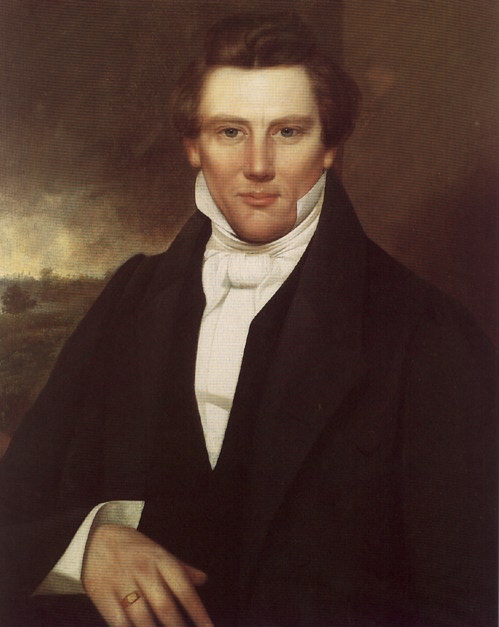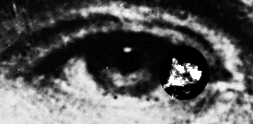DETAILS IN PHOTO REVEAL CLUES TO JOSEPH'S EXPERIENCES
Photography was first introduced in 1839 by a man named Louis-Jacques-Mandé
Daguerre. Therefore, examples of this new technology were called daguerreotypes.
History shows us that a photographer name Lucien R. Foster, moved to Nauvoo
in 1844 and lived with the Prophet Joseph at the Nauvoo Mansion. Brother
Foster was a branch president in New York City and after moving to Nauvoo,
was given responsibilities by the Prophet.
Joseph was murdered on the 27th day of June, 1844. The following August,
L.R. Foster moved out of the Mansion to a daguerreotype studio on Main Street.
During the time all Nauvoo was mourning the loss of their dear "departed
friend" the Prophet Joseph, Foster began advertising an exhibition
of his daguerreotypes. Curiously, part of his exhibit would be at the late
Prophet's home. It is logical that the daguerreotype of Joseph was displayed
there since records state it belonged to the Smith Family. Mr. Foster states
in his advertisement:
"How valuable or rather invaluable, would be such a likeness of an
absent or departed friend. Specimens may be seen...at the Nauvoo Mansion."
Joseph Smith III remembered Lucien Foster taking a picture of his father.
Later in his life, Joseph III would state that he owned the most accurate
oil portrait of Joseph Smith in existence. (see Fig. 1, below)
He based this assertion on the fact that the painting was "sustained"
in its likeness to the daguerreotype. Joseph Smith III copyrighted the daguerreotype
claiming it was his father, therefore, we will refer to the photograph
on the main page as the "JS Photograph" and to the oil painting
which resembles it as the "RLDS painting."

Fig. 1: The RLDS painting. This is the painting that Joseph III,
son of the Prophet, stated looked the most like his father due to the fact
that this painting most closely resembled his father's likness as seen in
his father's photograph. Therefore, any photograph of the Prophet must by
necessity resemble this painting.
Over the years, scholars have thought several photographs of Joseph were
taken from the RLDS painting. This painting offers striking resemblance
to the JS Photograph, in fact experts believe the painting must have been
drawn from the JS Photograph. Consider Joseph Smith III's statement, "It
fortunately happens to us that this portrait [RLDS painting]...is sustained...by
the daguerreotype in our possession."
The resemblance between these two images is not coincidental. Art authorities
say, that of all the contemporary depictions of the Prophet, this is the
only painting that reflects unusual talent, showing an uncommon frontal
view that would be very difficult for any artist associated with the Prophet
to accomplish in such a well proportioned way. However, through the assistance
of a photograph, even an average artist might paint an image of this quality.
Use of photographs as an aid to art was--and still is--a common practice.
The portraits painted from photographic images were considered more valuable
than the photographs themselves and understandably so, because photographs
revealed the true nature of the subject's face with all his flaws, scars,
asymmetry etc. On the other hand, paintings make a person look better and
more dignified. They are also more costly to produce. Photography was sort
of a "poor man's" art, since they were affordable to the common
people. Consequently we have numerous 19th century photographs of people
from all walks of life, exposing them as they really looked and lived.
It is the perfect reflection of nature found in photographs that intrigued
the experts examining the JS Photograph. It exhibits many natural details
that artists avoid when painting. Listed below are some of the more interesting
findings, not only from the Art and Photographic experts, but from Medical
experts as well. Notice:
1. There is an asymmetrical quality to the face caused in part by
the depressed maxillary area of the left cheek.
2. There is an apparent scar with swelling on the Prophet's upper
left eye-lid and a hint of a scar on the upper lip. (see Fig. 2, below)

Fig. 2: On the left side of the cupid's bow, just above the lip,
there is evidence of a scar in the JS Photograph. It is known that Joseph
had such a scar from a brutal attack when a mob tried to force him to drink
a veil of acid and broke a bottle on his upper lip.
3. Certain
areas of the photograph, especially the eyes, have a very photographic,
optically correct appearance. Enlargements of the eyes reveal eyelashes
and hints of blood vessels as well as other small anatomical details. (see
Fig.3, below)

Fig. 3: A computer contrasted view of the Prophet's right eye.
Some believe that blood vessels are visible under enhancement. Note the
branch-like viens in the contrasted dark circle to the right of the iris.
4. The iris of the eyes reveal detail so minute that even an
accurate pupillary reflex to light is evident and measurable. Joseph's left
pupil is exposed to more light than his right and has reacted by constricting
to become 25% smaller.
5. The Maxillo-Facial Surgeons indicate that Joseph's scar and swelling
of his upper left eyelid are evidence of a striking blow to that side of
his face resulting in the trauma evident in the JS Photograph. The scar
on his upper lip may have come from the beating he took at the Johnson home
when he was dragged out of bed in the middle of the night by a mob. They
flogged and tar and feathered him. Then a bottle of nitric acid was forced
into his closed mouth. The bottle cut his lip and chipped a tooth, but they
failed to accomplish their evil motives.
6. The button visible at the bottom right of the JS Photograph has
an out of focus, three dimensional, and extremely realistic, photographic
quality.
7. An expert in clothing styles and textiles found the weave of the
fabric in an enlargement of the area around the left collar and lapel. This
weave was found to be in the directions appropriate to the different cuts
of this style of clothing. The clothing detail and weave of the fabric would
be too tedious for an artist to paint. This expert also noted what appears
to be repair stitching next to the button. She stated that this stitch occurs
in just the right place to repair damage caused if someone were to grab
Joseph forcefully by the buttoned collar and lapel.
8. On the Prophet's coat there are many tiny details not readily
perceived by the naked eye. One can see the two button holes on his left
lapel, but what is not so obvious is a small button hole found when the
upper lapel area is magnified. A clothing expert said there should be a
small button hole there, and indeed, when the area was enlarged, there was.
It is hard to imagine a painter of Joseph's day caring about a tiny and
nearly invisible button hole.
9. Photographs reveal the true nature of a person's face. They show
every face is composed of two different sides. This difference can be illustrated
when you view a mirror or reversed image of a familiar face. The reversed
image, because you are not used to it, will look strange and possibly out
of balance. To demonstrate this, look at the cover photograph in the mirror.
This shocking effect is less noticeable when viewing reversed images of
Joseph's painted portraits because painters tend to clean up asymmetry and
remove facial flaws, giving the person a more symmetrical appearance.
10. Unquestionably there is a great deal of hand painting, retouching,
or other rendering involved in this photo. The odd outline of Joseph's hair
looks as if a stencil, frisket, or other masking or blocking device was
used. It is very clumsy and unconvincing, and it is the type of masking
which would more logically be done in painting a photographic print than
in creating a wholly non-photographic painting: it definitely produces an
effect which one finds in painted nineteenth-century photographic prints.
11. The JS Photograph exhibits the photographic principle of depth
of field. Note the image is in focus at the center and becomes progressively
out of focus the farther one looks from the focal plane. The eyes and face
are in focus but the shoulders are out of the focal length of the lens and
are therefore out of focus. This illustrates the three dimensional aspect
of the subject. In other words, the source of this image was not a two dimensional
flat object-like a painting-but a real physical object (i.e. a man). The
button on Joseph's left demonstrates this three dimensional, out of focus
quality as well. It looks like a real button, not a painted one.
12. The white shirt and tie (cravat) are overexposed, as is common
in photographs of the period. This happened because early photographers
could only guess at the exposure time, therefore light areas of a photograph
were commonly overexposed and had to be retouched in order to bring out
the shadows and form. This cravat has been retouched and is the only area
where brush strokes can be found.
<- BACK
NEXT CHAPTER ->